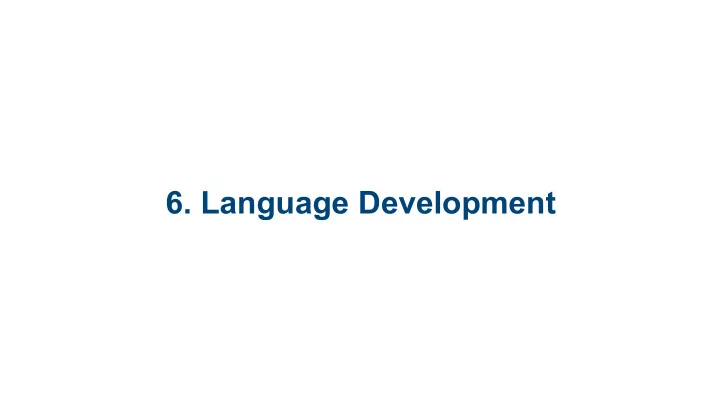

6. Language Development
6.1 Vocalization and Sound 6.2 Language and Thought 6.3 Development of Syntax
6.4 Semantic Development 6.5 Pragmatics
6.6 Environmental, Cultural, and Genetic Influences 6.7 Bilingualism
6.1 Vocalization and Sound
Infant sounds • Cooing vowels, then add consonant • 4-6 months all possible language sounds • Werker: phonemic discrimination by 12 mo. • Recognizes/makes sounds for native language
Infant sounds • Holophrasic speech 12-13 mo. (single words or partial words with several intentions) • Using partial words in later years indicates difficulty with phonology (sequencing sounds)
Theories of speech • Behaviorist: rewards for speech approximations • Nativist: Language Acquisition Device (LAD) • Specific brain areas adapted for language • Social cognitive: imitation
6.2 Language and Thought
Chicken or egg? • Language or thought first? • Can you think an object or idea without a word for it? • Evidence on both sides of argument
Chicken or egg? • Piaget: schemata build as language develops • Vygotsky: self-talk ➔ thinking
6.3 Development of Syntax
Creating sentences • Toddler’s 2-word telegraphic speech • Example: “More juice” • Preschoolers speak in whole sentences
Creating sentences • Overregularization: apply rule instead of exception • Example: “We goed to a movie.”
6.4 Semantic Development
Word meanings • Carey: young vocabulary explosion uses “fast mapping” – associating new word with old schema • Or do children just guess at word meaning, refine later? • Young children literal, can’t understand metaphor or figures of speech
6.5 Pragmatics
Usage defined by context • Speech altered by where you are or who is listening • Example: Use different words or phrases at home and at school • Example: Switching between ethnic and “standard” speech
6.6 Environmental, Cultural, and Genetic Influences
Language and culture • American: many first words nouns (names of things) • Chinese: many first words verbs (actions and relationships) • Whorf: linguistic relativity • Culture and environment shape perception and language
6.7 Bilingualism
Bilingual children • Best to learn 2 nd language in early childhood (sensitive period) • Learning two languages simultaneously might cause temporary delays • Research: more brain activity than monolingual children
Recommend
More recommend